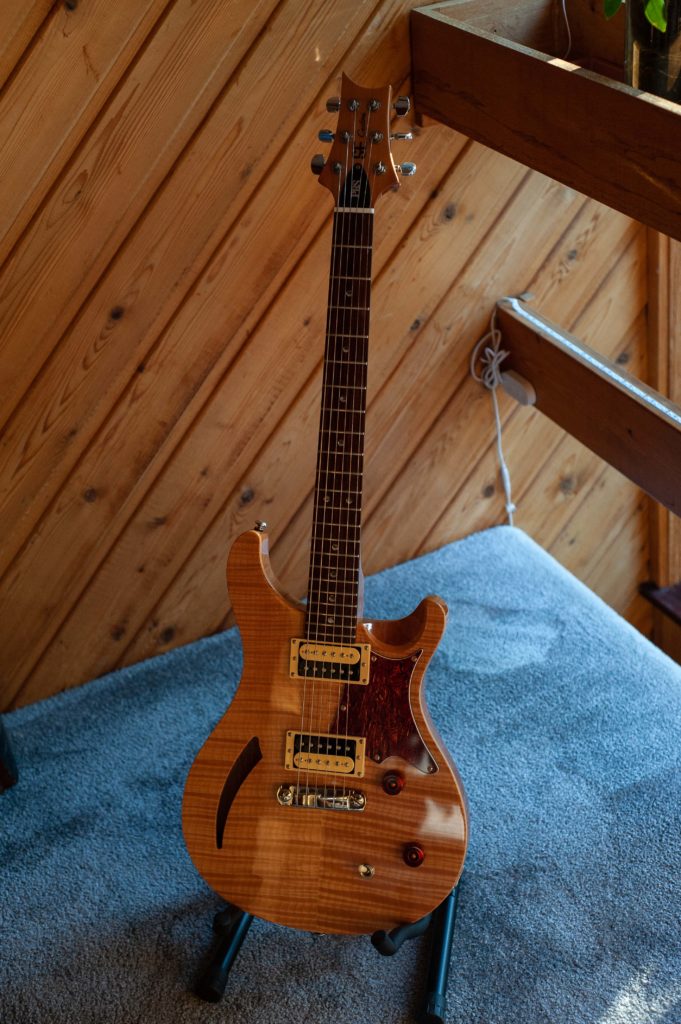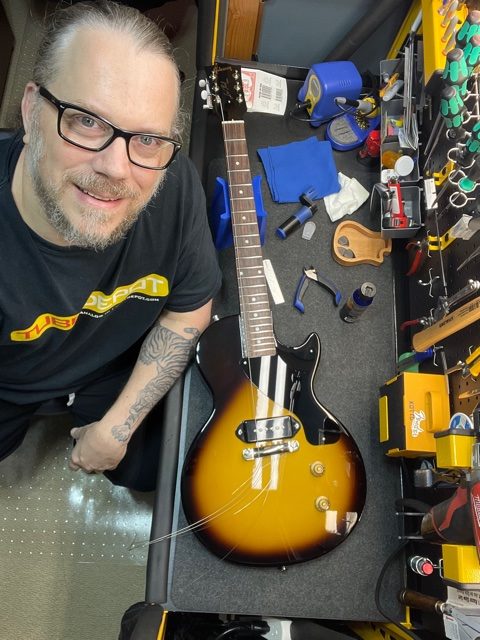Fan…….. I hate that word. It always brings to my mind screaming teeny-boppers at a pop concert. I am not a fan of anything and if I should end up so labelled then you have my permission to take me outside and shoot me. As I said I am not a fan of anything but for some things I am an aficionado. In particular I think of myself as a Jazz Guitar Aficionado. I have been listening to Jazz Guitar my entire adult life. Probably the first jazz guitar recording I came across was the 1929 recording of Knocking a Jug featuring Edie Lang with the Louis Armstrong Orchestra.
In many ways, musically and culturally, it was a landmark recording. It must have been one of the first inter-racial bands on record. Edie Lang was white and Louis Armstrong was black. Edie Lang pretty well killed off the use of the banjo in jazz. After Edie Lang came along banjo players started switching to guitar. Edie went onto to make a whole series of classic recordings with the jazz violinist Joe Venuti. Following a routine tonsillectomy in 1933 he died at the age of 30. In 1977, Lang’s recording of Singing the Blues with Frankie Trumbauer and Bix Beiderbecke was inducted into the Grammy Hall of Fame.
The other great guitarist of that era is the French gypsy guitarist Django Reinhardt, who along with the violinist Stephane Grapelli took American Jazz and invented a whole new style of playing, one with a particularly French flavor. It became a whole new genre of jazz called Manouche or Gypsy Jazz .
I suppose to modern ears those recordings sound quaint but it must be remembered that at the time of the recordings around 90 years ago the technology of the day was pretty primitive and musicians spent as much time fighting the technology as they spent on learning their craft. For guitarists things did not really get better until the invention of electricity, specifically the electric guitar. Charlie Christian wasn’t the first electric guitarist but he was the one who virtually invented the electric guitar vocabulary and has pretty well influenced every electric guitar player who came after him. With the electricity came the volume that allowed guitarists to step up to the plate and join the front line of the band. They now had the ability to play complex harmony, unison lines and solos and actually be heard. That changed the texture and style of the music.
Charlie Christian opened the flood gates and in the post war period and even up to the present day there are so many electric jazz and rock guitarists that he influenced that to just name them would fill a book. He died of tuberculosis on March 2, 1942, at the age of 25.
What does that have to do with the Paul Reed Smith Custom SE Semi-Acoustic Guitar in the photo below? Even with the invention of the solid body electric guitar jazz players seemed to favor the carved top orchestral guitar with its big body and characteristic f-holes. Rightly or wrongly in my mind the sound of Jazz Guitar became associated with the carved top orchestral guitar.

It was only much after I heard the Canadian jazz guitarists Ed Bickett and Oliver Gannon play exquisite jazz on a Fender solid body guitars that I realized that it was possible to get an authentic jazz sound on something hardly more than a piece of two by four with a fret board and a pickup. So maybe I didn’t have to spend a fortune on a “jazz guitar”. Semi-hollow body guitars like the Paul Reed Smith are a compromise between the classic arch top and the Fender style solid body guitar
I first saw and heard a YouTube review of this particular Paul Reed Smith model about 12 years ago. I will admit the instrument just looked so pretty that I couldn’t resist it. The price was modest so I purchased one. However, I never really got to grips with using it in performance. At the time I was looking for a cool jazz sound and in pursuit of that ideal I installed some high priced European flat wound strings. They were thicker than the set on the instrument and I had to file the slots in the nut to accommodate them. The result was I ruined the nut. To repair the damage I would have had to travel out of town to find an artisan to do the job. As a result the guitar has just been sitting on my wall unplayed and, despite its good looks, unloved. Earlier this year I did find a replacement nut on Amazon. I would have liked to install one of those fancy zero fret nuts but I wasn’t sure of the sizing. Any way, the Amazon nut was almost a perfect fit and it got the instrument almost back to normal. It did the job. After replacing the nut I tried to set up the guitar and, although I did have some success with that it was not perfect. Well, about two weeks ago I learnt that there was a guy in town, Darin Massicotte, who could do a professional set up. So last week I got him to install and set up D’Adddario Chrome Medium Flat Wound strings on the guitar. For the princely sum of only $60 he did a fabulous job. There is still a little “pinging” on the top E string around the 10-12th fret but we are going to let the instrument settle for a few weeks then re-adjust. I am impressed with the final outcome. The strings are super smooth, absolutely unbelievably smooth, and the sound is nice, rich and mellow and with a little reverb and chorus it is the sound I have been seeking. It’s a pleasure to just sit down and practice dumb scales and arpeggios. So that’s what I have started working on again but it is like learning a new instrument. Compared to acoustic guitars, electric guitars are different and the music, particularly jazz, requires a different approach to master the sound and the phrasing. So with time I have high hopes of maybe getting to eventually play some faux jazz. Maybe even have a shot at Kenny Burrell’s Midnight Blue. I may never get to play “real” jazz but I think I will have fun trying.
I am so taken with the flat wound strings that I am going to install a light set on my Irish Bouzouki. That instrument needs some fret work etc and with some help from Darin it would be nice to get the instrument back into shape. If the Chrome strings works on the Irish Bouzouki I will probably do the same for my Cittern and get Darin to sort out the balance on the pickup. The Chrome strings are expensive and I suspect they will not last long. So for the Bouzouki and Cittern I am looking at around $30-40 to install new strings (two sets for each double course instrument). If I get 6 months out of them I will be happy.
@@@@@@@@@@@@@@@@
Post Script: Darin Massicotte – Guitar Tech

“Originally from Edmonton, now a Cranbrook native of 22 years. I moved here with my wife to be in the mountains and ride mountain bikes and ski. I have a always had an interest in guitars. I had a love for punk rock music and after a friend taught me the basics I started playing guitar. Years later I discovered my ability for repairing and setting up stringed instruments, particularly guitars. I have a mechanical background kin repairing bicycles and in precision wood work.
Due to a fairly recent injury I found myself having a difficult time being employable. With that I discovered that my hobby of instrument repair was a desirable skill in the community and people began bringing me their guitars for repair. Word of mouth is big in small communities and word travels fast and I’ve become busy with my “hobby” and have made many new friends over the time. Whether setting up a brand new guitar or re-fretting an old friend, it’s all enjoyable and I learn from each instrument.
I try to get repairs done in a timely manner, limiting the amount of time that you’re without your instrument. Appointments are the best way to do this and I usually only require a day or two with your guitar unless unusual parts are needed or extensive glueing is required.
Next time you need some work done feel free to give me a call.”
Darin Massicotte’s workshop is called Kootenay String Works and he is located in Cranbrook, B.C.
Telephone number: 250-489-8887
Email: Kootenaystringworks@gmail.com
@@@@@@@@@@@@@@@@
